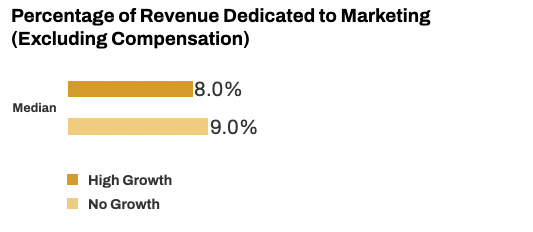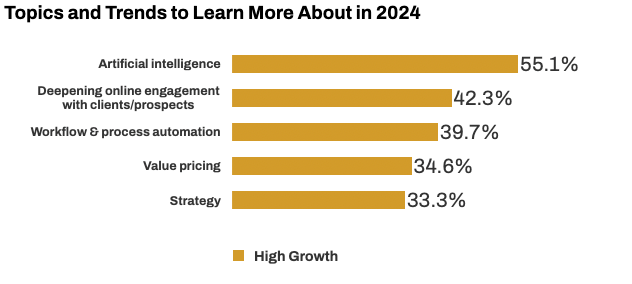Earlier this year, we released our annual High Growth Study, including a special report on the accounting & financial services industry. Today, we’d like to share a few key findings from this industry report, as well as insights into what the data means for your firm.
2023 (the year we collected the data) was a hopeful one: After a slowdown in 2022, growth picked up, averaging 12.3% across the industry. Market uncertainty, which has been a top concern for the past few years, moderated somewhat, though it remains an underlying worry.
But significant challenges still lie ahead. Compensation rose as firms competed for a shrinking pool of talent. Artificial intelligence made huge strides forward as ChapGPT and other large-learning-model technologies burst on the scene, their tremendous promise dampened somewhat by a large dose of apprehension.
The study focuses on one particular group—that subset of firms that achieves superior growth and profitability year after year. By studying these High Growth firms we offer accounting or financial services firms like yours insights that you can apply to your own practice.
About the Study
242 accounting & financial services firms participated in this ninth edition of the High Growth Study, representing $6.9 billion in combined revenue and more than 32,000 employees. This was the second largest sample in the study (see figure below).

Participants represented firms of all sizes, and they conducted business in every region of the globe.
In the study, we grouped the participants into categories, including High Growth (see definition in the section below) and No Growth (those that experienced zero or negative growth).
Meet the High Growth Firms
We define High Growth firms as those firms that achieve at least 20% compound annual growth over a three-year evaluation period. We contrast these firms against those that experienced little or no growth over the same time frame. This allows us to identify strategies and practices that are associated with faster growth and higher profits.
This year’s High Growth accounting & finance firms grew at a median rate of 35%—more than three times faster than their No Growth peers.
High Growth firms are also more profitable than their slower-growing competitors. High Growth firms enjoyed a profit of about 25%—more than two times that of the No Growth contingent.

What gives these fast-growing firms such an advantage? We look at some answers next.
1: High Growth Firms Spend Less on Marketing
Remarkably, the fastest growing firms achieve better performance without spending more on marketing. In fact, they spend slightly less.

How do they do it? In part, they are more efficient. For instance, they are more mature users of technology, which allows them to do more with less effort. Also, they know which marketing techniques work for their audience, and which are a waste of time.
2: They Use More Marketing Techniques
As you can see in the figure below, the top-performing firms are more likely to use a wide variety of marketing techniques than their No Growth peers. In this list, you can see which techniques High Growth firms use most often. These include networking on social media and at live events, producing high-quality business development materials, email marketing and writing blog posts.

The techniques they use address all stages of the marketing funnel, from top-level visibility to closing new business. Compare your top marketing tactics to this top-5 list and see how you stack up.
(Note: For the complete list—as well as a rundown on which techniques deliver the greatest impact—see the full report.)
3: High Growth Firms Are Creating More Content this Year
High Growth firms are restless. They think a lot about the future and what’s changing in the marketplace. That means they test different marketing techniques and they look for new efficiencies that will give them an advantage.
In the list below, we see which marketing techniques these firms are planning to invest in this year. At the top of their list is creating content. Producing high-quality educational materials such as articles, blog posts, guides, white papers, and webinar recordings is a proven way to build your visibility and allow people to sample your expertise. Used in conjunction with other techniques, such as web offers, SEO and email marketing, content is not only a stellar way to introduce new people to your firm, it’s a powerful tool to generate leads and build a loyal following over time.
Marketing technologies are an important way High Growth firms create efficiencies. Social media marketing provides another channel to reach prospects. Differentiation is a cornerstone of sustained business success, especially in an industry with so many look-alike firms. And getting the right marketing mix… well, that’s one thing High Growth firms seem to do remarkably well.

4: They Are Interested in AI and Engaging Clients Online
Like a point guard in basketball, High Growth firms are always looking ahead for the next opportunity and the perfect play. To understand where high-performing firms are looking next for an advantage, we asked what they planned to learn more about in the coming year.
Not surprisingly, artificial intelligence—a topic that is everywhere in the news today—is on the top of their minds. They also want to find new ways to engage prospects and clients in the digital realm. Increasingly, this is where buyers look to find expertise and to learn about solutions to their business problems. In addition, they are looking to technology to automate their processes and create efficiencies. Value-based pricing offers a way out of the commoditized services trap and allows a firm to capitalize on its expertise. And strategy provides a framework for building a competitive advantage in a challenging marketplace.

5: High Growth Firms Outsource More Marketing Skills
The chart below shows the top five marketing skills outsourced by High Growth firms. In each case, the High Growth group outsources specialized skills more often than their No Growth competitors. Why? Three reasons: 1) They only pay for expertise when they need it; 2) They get access to specialists who use the latest tools and know their area of expertise better than most in-house generalists; and 3) They get better results—and often the metrics to prove it.
All five of these disciplines require deep technical proficiency to deliver at a high level. And even those that can’t be easily measured, such as graphic design and marketing materials development, have strong implications on a firm’s perceptions and brand.

Build a Resilient Marketing Program
While growth in the accounting & financial services industry accelerated last year, the industry overall has plenty to worry about: consolidation of firms, including deepening private equity interest in the industry; new business models; rising salaries; managing a remote workforce; the commoditization of traditional services; and a difficult labor market, to name just a few.
The most successful firms accept that the marketplace is changing and they have built their firms to adapt. Some are doing frequent research to understand how their buyers’ preferences are changing. Others are adding advisory services to their lineup. Many are finding new ways to attract, engage and nurture prospective clients—investing in techniques such as educational content, high-performance websites and social media.
They are also spending less on marketing, in part by creating flexible marketing departments that rely more on specialized, outsourced expertise rather than large, jack-of-all-trades internal teams. And they have learned, often by careful experimentation, what techniques work, so they waste less of their marketing budget on fruitless activities.
If you want to learn from the best-performing accounting & financial services firms, start by studying the data above and comparing it to what you do at your firm. If you want to learn more, consider purchasing the full industry study. Or reach out to Hinge to learn how you can emulate their success.


